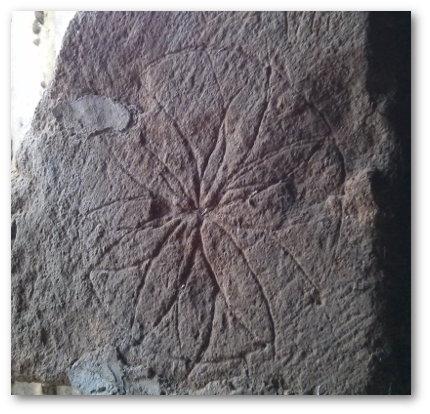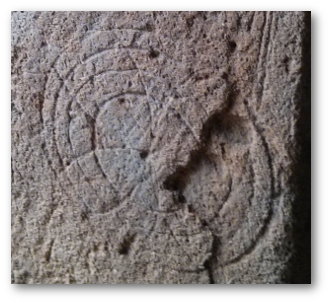Ritual Protection Marks in Vernacular Buildings: ‘House Magic"
It is unusual to find a standing building that pre dates the C14th hence we can only note that ritual protection has taken place for centuries, even into pre history. Indeed we still do it now - horse shoes nailed above or primroses or garlic near the entry door.
With a strong focus on the construction and evolution of buildings surveyed no one paid particular attention to minor detail like strange and difficult to see marks or indeed deposits until Timothy Easton astounded a Vernacular Architectural Group Conference during the 1980’s coining the phrase ‘apotropaic marks’. These marks were noted from the mid C16th through to the mid C18th, peaking in the C17th.
Apotropaic marks are scribed onto wood or stone, usually during the construction of the building and often by tradesmen. They are frequently small, feint and difficult to see except in the direct light of an angled torch. They thus appear to have no practical or decorative purpose. They are commonly located in the ‘drafty’ parts of the domestic building; the doorways, the windows, stairways and the hearth, places where ‘evil’ can be assisted to enter by moving air.
The marks can occur as straight lined, almost runic, scratched letters and crosses or the more easily identified circular shapes.

Straight lined scratched letters:
The Marian Symbols.
During the Reformation of the C16th images associated with the Virgin Mary and the "Marian Cult" were removed from churches but the associated symbols were adopted by tradesmen, "t" and "o" used avert evil. Conjoined "V"s’ presenting as "W" or when inverted as an "M" stand for Virgo Virginum, Virgin of Virgins.
The M may be conjoined with an R, Mary Regina, or either the W or M with a P, this may be a plea to bring "pace", peace, to the house. A compact combination of AMR, Ave Maria Regina, is sometimes found .
The St Andrew’s Cross and butterfly shapes.
In a magical context this shape cannot be inverted or turned back on itself thereby destroying its function, even possibly creating evil. Blacksmiths often use them on door latches and window stays. It seems that the 2 lines represent the jambs of the door or window and the St. Andrew’s cross barred entry through them. The ‘Heck Posts’ found in Yorkshire are adorned by the St Andrew’s Cross.
Circular Marks:
Great circles in the form of ‘henges’ have existed for thousands of years as ‘protected places’; in vernacular buildings circles serve the same purpose but are smaller!

The Hexafoil or Daisy Wheel:
This is the most commonly found apotropaic mark; it is seen as both a protection against evil and a good luck symbol and is often found in food preparation areas. It is usually incomplete, perhaps as a gesture of respect for the deity who could create perfection. This ancient image for the sun can be traced back to at least the C6th BC. In many cultures the hexafoil was used on grave and standing stones. It seems to have been phased out of official English ecclesiastical symbols around the C14th, but continued in secular ritual use after that.

There are other circular marks - concentric circles, spectacles etc - but they are not especially common. Markings may be found in groups of 3 to symbolise the Trinity and a 3 petalled star within a circle may also be a Trinity sign.
We have so far discussed buildings but these marks occur underground, certainly in our own Mendip Hills, too. Linda Wilson & Chris Binding have done some sterling work, particularly in Wookey Hole Caves (Binding & Wilson 2010). A March 2015 communication with Chris says that he and Linda may be ‘on to something’ and hope to publish by the end of the year – watch this space!
The ‘I’ symbol is also used underground in Wookey Hole. This is believed to represent the letter ‘J’, not used in Latin. Inscribed it is often followed by an ‘H’. IH are the first two letters of the Greek form of Jesus. IHC or HIS are common Christograms.
Additional information
The following sites may also be of interest: Apotropaic Symbols on Cast-Iron Firebacks